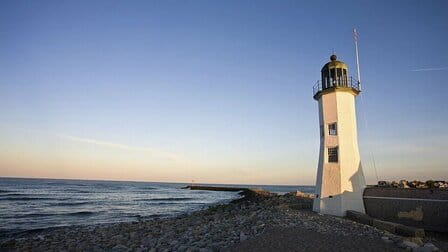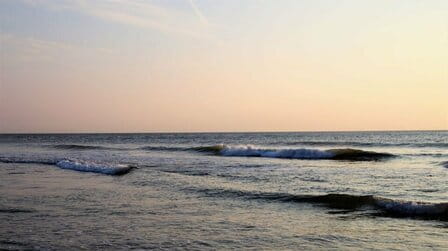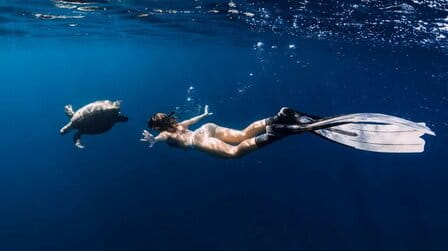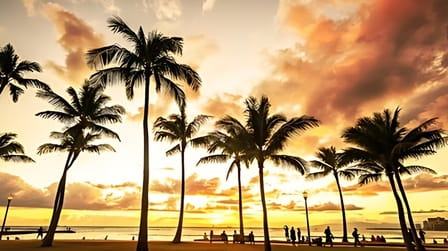This article serves as a primer, providing a brief overview of key characteristics of aloha shirts and the vocabulary used to describe them. Reading the recommended sources can help you go further into the topic at hand.
Fabric for Making Clothes
Cotton, rayon, and occasionally other textiles like silk are used to make aloha shirts. Between a wholly natural fabric (like cotton or silk) and a completely synthetic fiber (like polyester), rayon, a "regenerated" or "manufactured" fiber, occupies a middle ground. To make this fiber, natural wood pulp is dissolved and the resulting material is mechanically extruded. The rayon used to make aloha shirts has a supple, smooth, and sometimes slippery feel. It's far more flexible than cotton, and it drapes much better. Vintage rayon shirts from the 1950s and 1960s are quite popular among collectors.
Neckline

Pouch
Most aloha shirts have one patch pocket on the left chest. Shirts designed for ladies are often built without pockets, but versions with two pockets do exist. Manufacturers may go the extra mile to provide a matching pocket. A matched pocket, also known as a patch or flap pocket, is one that has been carefully cut and sewn such that its pattern matches the pattern of the shirt's body. Although matched pockets are a notable characteristic of quality on aloha shirts, they were not always employed, and several reputable historical brands manufactured shirts without them. There are also, albeit less commonly, shirts available with front plackets that are matched.
Fasteners

Types of Printing
Regardless of the specific flowers, animals, or other themes they portray, patterns on Hawaiian shirts can be broken down into a few broad categories.
All-inclusive manual
The most typical type of aloha shirt design is a complete print, which completely covers the shirt in a uniform pattern. The placement of the print on the shirt is unrelated to any details of its production, including the cuts and seams, other than its overall orientation. If you had to imagine a typical Hawaiian shirt, it would look somewhat like this.
Directionally patterned printing
Some extensive repeating patterns can be broken down into multi-directional prints, such as single-direction, double-direction, or quadruple-direction, to show the variety of ways in which the topic is structured.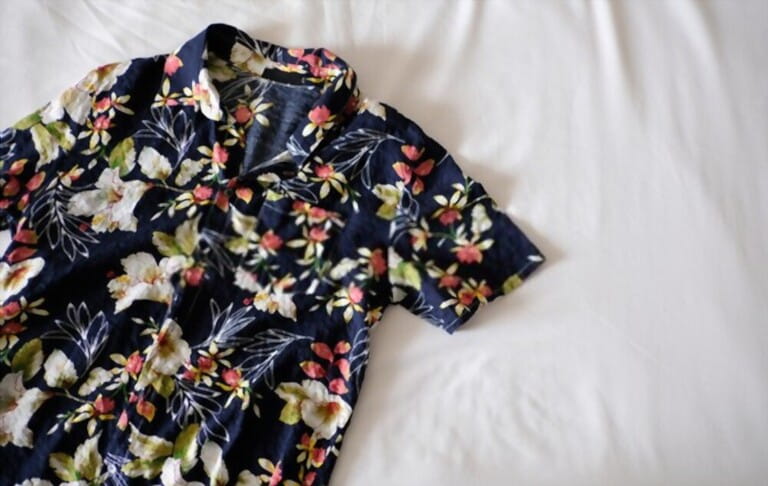
Printing with a plan
To get a structural print, the print pattern must be strategically placed in respect to the shirt's cuts and seams. In contrast to a comprehensive print, the elements of a structured print are planned to take up discrete real estate on the final garment.
Prints on the edges and the breaks
Structured prints include both edge prints and segment prints, with no clear winner in terms of nomenclature. Some books and websites use one phrase to refer to both kinds of shirts, while others use the opposite term.
One of these names describes a type of print design identified by a huge pattern that begins at the shirt's hem and extends vertically across the shirt's front and back. The other phrase describes a pattern that runs vertically or horizontally without interruption anywhere on the garment, most often on each side of the front placket.
When forced to choose, it seems that most people mean by "edging print" the linear patterns and by "segment print" the large anchored motifs.
Printed in reverse
Inverted print shirts are popular among native Hawaiians because of its "faded" or "washed-out" appearance, achieved by the use of muted colors and subtle print patterns. Printing on one side of the fabric while stitching the shirt to expose the unprinted side was first popularized by the Reyn Spooner brand.
Traditional pattern prints
It's worth breaking off several famous classic repeating print design types into their own articles.
Pareu
Pareu have solid-color backgrounds coupled with simple white floral motifs, are still popular today. Red and blue backgrounds predominate, but green, yellow, and purple can also be seen. The patterned fabric used in traditional Tahitian pareu wraps dates back to the 1800s, and for a while, these patterns were marketed as "Tahitian print." The fabrics we now identify with Tahiti actually originated in Europe, where they were designed, woven, and printed.
Tapa Tapa
Design elements typical of Tapa Tapa are rough, abstract geometric patterns with a Polynesian, tiki, or tribal flavor. These patterns were hugely fashionable in the '50s but have since faded from fashion. Tapa patterns are based on those seen in traditional Samoan barkcloth and are typically displayed in a variety of brown tones.
Palaka
Palaka shirts, traditionally worn by Hawaiian farmhands and "paniolo" cowboys, are easily recognizable thanks to their distinctive white plaid design over a solid background. Even though it's been called "Hawaiian denim," the original palaka shirts were actually constructed of a thicker, more durable fabric and typically had longer sleeves. Even though they don't seem like the typical aloha shirt, we'll talk about them anyhow because they were the inspiration for the shirts we wear today.
Botanical motifs appear frequently
Floral patterns are a trademark of Hawaiian clothing. Pineapples, palm trees, bananas, and other tropical motifs are easily recognizable by fans of relaxed clothing. Although many aloha shirts feature prominent exotic plants, numerous lesser-known species are also popular.
Hibiscus
The hibiscus, representing a genus of tropical flowers including a few hundred unique species, is arguably the most common botanical motif on Hawaiian shirts. You can find these massive, trumpet-shaped blooms in a rainbow of hues, from red and purple to pink and yellow. The yellow hibiscus, or hibiscus brackenridgei in its scientific form, is the state flower of Hawaii.
Paradise bird
The striking bird of paradise flower, or Strelitzia reginae in scientific terms, is commonly employed as a decorative element. Bright orange sepals and luminous blue or white petals curl upward out of a stiff, pointed spathe in this South African native flower, creating an arrangement closely mimicking the head of a tropical bird.
Plumeria
Plumeria is a genus of flowering bushes that is native to Central America but can now be found across the Pacific Islands, making it a popular design element for aloha shirts. These five-petaled blooms are incredibly fragrant, especially after the sun goes down, and can be found in a rainbow of colors. Leis are commonly made of plumeria.
Flowers in the genus Anthurium are easily identified by its heart-shaped spathe (often represented on red, pink, or white t-shirts) and their sharp, projecting spadix.
The big, southern Mexican-native Monstera deliciosa plant is a common secondary motif on aloha shirts. The large, waxy, lobed leaves have a unique, tropical feel to them. These holes become more prevalent in Monstera's leaves as they age, earning the plant its other common name, "Swiss cheese plant."
The "shaving brush tree," or Bombax Pseudobombax ellipticum, is actually native to South America but is a popular decorative plant in Hawaii. The spring flowers barely survive a day but look like an explosion because to their curled-back sepals and cluster of long, slender stamens. You may get them in both white and pink. The fluffy threads that encase the seeds of this plant got it the nickname "false cotton," and those fibers were once utilized for both insulation and stuffing pillows.




